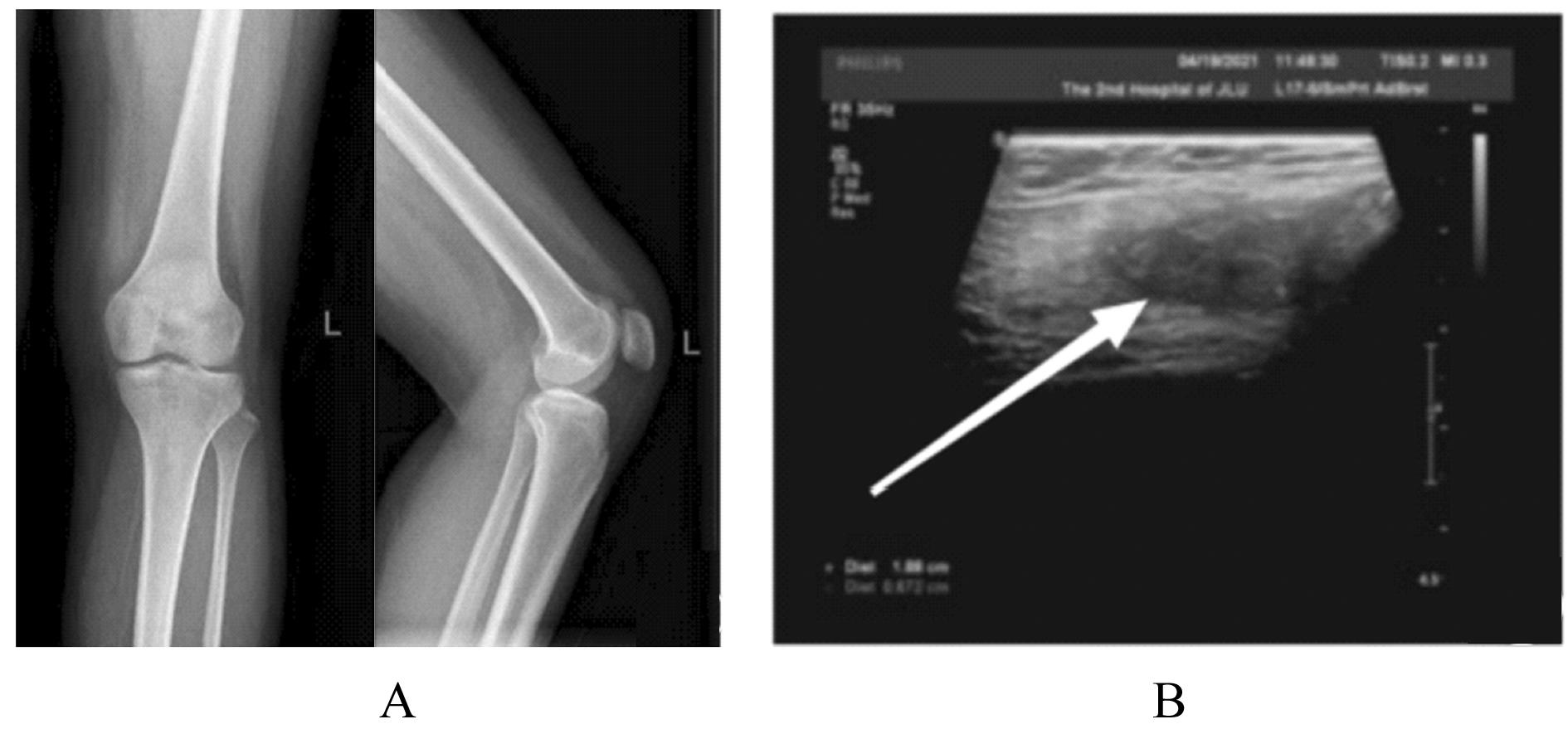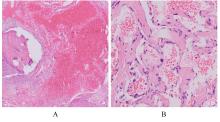| 1 |
DERZSI Z, GURZU S, JUNG I, et al. Arteriovenous synovial hemangioma of the popliteal fossa diagnosed in an adolescent with history of unilateral congenital clubfoot: case report and a single-institution retrospective review[J]. Revue Roumaine De Morphol Embryol, 2015, 56(2): 549-552.
|
| 2 |
SLOUMA M, HANNECH E, MSOLLI A, et al. Synovial hemangioma: a rare cause of chronic knee pain[J]. Clin Case Rep, 2022, 10(7).DOI: 10.1002/ccr3.6007 .
doi: 10.1002/ccr3.6007
|
| 3 |
LOPEZ-OLIVA C L L, WANG E H M, CAÑAL J P A.Synovial haemangioma of the knee: an under recognised condition[J]. International Orthopaedics (SICOT), 2015, 39(10): 2037-2040.
|
| 4 |
CHOUDHARI P, AJMERA A. Haemangioma of knee joint: a case report[J]. Malays Orthop J, 2014, 8(2): 43-45.
|
| 5 |
HOE H G, ZAKI F M, RASHID A H A. Synovial Haemangioma of the Elbow: a rare paediatric case and imaging dilemma[J]. Sultan Qaboos Univ Med J, 2018, 18(1): e93-e96.
|
| 6 |
ARSLAN H, İSLAMOĞLU N, AKDEMIR Z, et al. Synovial hemangioma in the knee: MRI findings[J]. J Clin Imaging Sci, 2015, 5: 23.
|
| 7 |
HERNÁNDEZ-HERMOSO J A, MORANAS-BARRERO J, GARCÍA-OLTRA E, et al. Location, clinical presentation, diagnostic algorithm and open vs. arthroscopic surgery of knee synovial haemangioma: a report of four cases and a literature review[J]. Front Surg, 2021, 8: 792380.
|
| 8 |
MOON N F. Synovial hemangioma of the knee joint. A review of previously reported cases and inclusion of two new cases[J]. Clin Orthop Relat Res, 1973(90): 183-190.
|
| 9 |
OKAHASHI K, SUGIMOTO K, IWAI M, et al. Intra-articular synovial hemangioma; a rare cause of knee pain and swelling[J]. Arch Orthop Trauma Surg, 2004, 124(8): 571-573.
|
| 10 |
SPENCER S A, SORGER J. Orthopedic issues in vascular anomalies[J].Semin Pediatr Surg,2014,23(4): 227-232.
|
| 11 |
SHYAM K, ANDREW D, JOHNY J. Progressively growing paediatric knee swelling: synovial haemangioma[J].BMJ Case Rep,2021,14(9): e242694.
|
| 12 |
COTTEN A, FLIPO R M, HERBAUX B, et al. Synovial haemangioma of the knee: a frequently misdiagnosed lesion[J]. Skeletal Radiol, 1995, 24(4): 257-261.
|
| 13 |
TOHMA Y, MII Y, TANAKA Y. Undiagnosed synovial hemangioma of the knee: a case report[J]. J Med Case Rep, 2019, 13(1): 231.
|
| 14 |
BENNETT G E. Hemangioma of joints[J]. Arch Surg, 1939, 38(3): 487.
|
| 15 |
孙英彩, 崔建岭. 滑膜血管瘤影像学研究进展[J]. 国际医学放射学杂志, 2011, 34(5): 461-463.
|
| 16 |
MATTILA K A, ARONNIEMI J, SALMINEN P,et al. Intra-articular venous malformation of the knee in children: magnetic resonance imaging findings and significance of synovial involvement[J]. Pediatr Radiol, 2020, 50(4): 509-515.
|
| 17 |
吴伟智, 张家雄, 彭加友, 等. 膝关节滑膜血管瘤MRI诊断[J]. 影像诊断与介入放射学, 2021, 30(1): 49-53.
|
| 18 |
DIOMEDA F, SANTANIELLO M, BRACCIOLINI G,et al. Intra-articular venous malformations of the knee: a diagnostic challenge[J]. Pediatr Rheumatol Online J, 2021, 19(1): 153.
|
| 19 |
高志鹏, 林 刚, 郭海滨, 等. 儿童髋关节滑膜血管瘤1例报道并文献复习[J]. 实用骨科杂志, 2022, 28(6): 568-570.
|
| 20 |
O’SULLIVAN P J, HARRIS A C, MUNK P L. Radiological features of synovial cell sarcoma[J]. Br J Radiol, 2008, 81(964): 346-356.
|
| 21 |
LARBI A, VIALA P, CYTEVAL C, et al. Imaging of tumors and tumor-like lesions of the knee[J]. Diagn Interv Imaging, 2016, 97(7/8): 767-777.
|
| 22 |
宋 亚, 李超峰, 史晓通, 等. 膝关节滑膜血管瘤1例[J]. 中国骨伤, 2018, 31(12): 1153-1155.
|
| 23 |
RUDD A, PATHRIA M N. Intra-articular neoplasms and masslike lesions of the knee: emphasis on MR imaging[J]. Magn Reson Imaging Clin N Am, 2022, 30(2): 339-350.
|
| 24 |
赵洪波, 周宏艳, 陈德生, 等. 关节镜下诊疗膝关节滑膜血管瘤病八例报告[J].中国骨与关节杂志,2014,3(6): 439-442.
|
| 25 |
AURAN R L, MARTIN J R, DURAN M D, et al. Evaluation and management of intra-articular tumors of the knee[J]. J Knee Surg, 2022, 35(6): 597-606.
|
| 26 |
MURAMATSU K, IWANAGA R, SAKAI T. Synovial hemangioma of the knee joint in pediatrics: our case series and review of literature[J]. Eur J Orthop Surg Traumatol, 2019, 29(6): 1291-1296.
|
| 27 |
DUNET B, TOURNIER C, PALLARO J, et al. Arthroscopic treatment of an intra-articular hemangioma in the posterior compartment of the knee[J]. Orthop Traumatol Surg Res, 2014, 100(3): 337-339.
|
| 28 |
PAI S N, AYYADURAI P, PERUMAL S, et al. Anterior cruciate ligament haemangioma[J]. BMJ Case Rep, 2022, 15(1): e248058.
|
| 29 |
DÜRR H R, KLEIN A. Diagnosis and therapy of benign intraarticular tumors[J].Orthopade,2017,46(6):498-504.
|
| 30 |
王轶博, 许守辉, 徐慧英. 关节镜治疗膝关节滑膜血管瘤1例[J]. 中国骨伤, 2019, 32(2): 173-175.
|
 )
)











